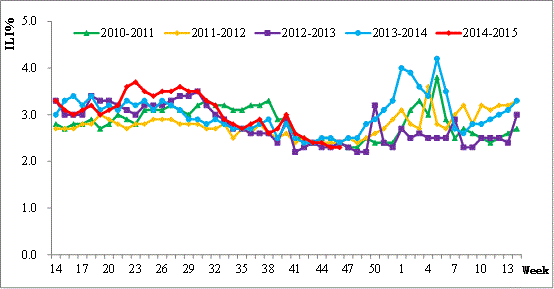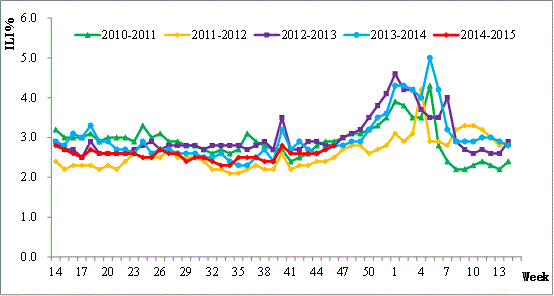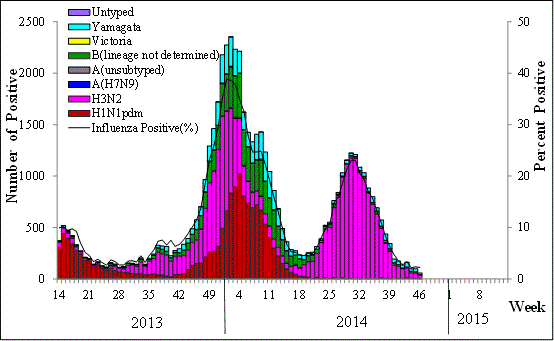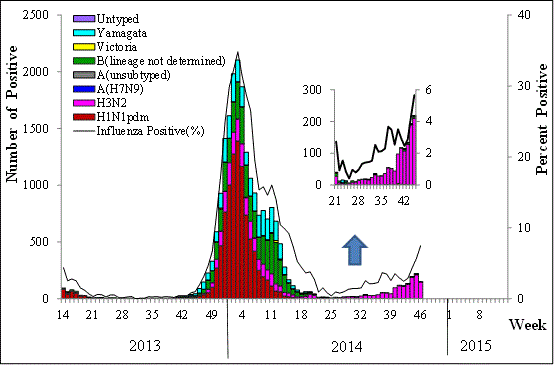Weekly Report
Week 46 2014
Article source: Date time:2014-11-24
Download:6.pdf
Chinese Influenza Weekly Report
(All data are preliminary and may change as more reports are received)
|
Summary l During week 46, 2014, the influenza activity was at low level in south China, and influenza activity continued to increase in north China in this week. Influenza A(H3N2) viruses were predominantly reported in both south and north China. l Among influenza viruses antigenically characterized by CNIC since April, 2014, 128(100%) influenza A(H1N1)pdm09 viruses were characterized as A/California/7/2009-like; 986(99.5%) influenza A(H3N2) viruses were characterized as A/Victoria/361/2011(H3N2)-like; 364(89.2%) influenza B/Yamagata viruses were characterized as B/Massachusetts/2/2012-like. 15 (44.1%) influenza B/Victoria viruses were characterized as B/Brisbane/60/2008-like. l Among the influenza viruses tested by CNIC for antiviral resistance analysis since April, 2014, all influenza A(H1N1)pdm09 and all influenza A(H3N2) viruses were resistant to adamantine; all but 1 influenza B viruses were sensitive to neuraminidase inhibitors, all influenza A(H1N1)pdm09 and all influenza A(H3N2) viruses were sensitive to neuraminidase inhibitors. |
Outbreak Surveillance
During week 46 (Nov 10–Nov 16, 2014), seven ILI outbreaks were reported nationwide. Five of them were A(H3) outbreaks, and etiology of 2 outbreaks was not determined yet.
Surveillance of outpatient or emergency visits for Influenza-like Illness (ILI)
During week 46, the percentage of outpatient or emergency visits for ILI (ILI%) at national sentinel hospitals in south China was 2.3%, same as the last week (2.3%), lower the same week of 2010-2013 (2.4%)(Figure 1).

Figure 1. Percentage of Visits for ILI at Sentinel Hospitals in South China (2010-2015)
During week 46, ILI% at national sentinel hospitals in north China was 2.8%, higher than the last week (2.7%), same as the same week of 2012 and 2013 (2.8%), lower than the same week of 2010 (2.9%), higher than the same week of 2011 (2.5%) (Figure 2).

Figure 2. Percentage of Visits for ILI at Sentinel Hospitals in North China (2010-2015)
Virologic Surveillance
During week 46, influenza network laboratories tested 4621 specimens, of which 208 (4.5%) were positive for influenza, influenza A and influenza B virus were 187 (89.9%) and 21 (10.1%),respectively (Table 1). During week 46, the percentage of specimens that were tested positive for influenza in south China was 2.2%, which was less than the previous week (2.4%) (Figure 3). During week 46, the percentage of specimens that were tested positive for influenza in north China was 7.5%, which was higher than the previous week (5.7%) (Figure 4).
Table 1 Laboratory Detections of ILI Specimens (Week 46, 2014)
|
|
Week 45 |
||
|
South China |
North China |
Total |
|
|
No. of specimens tested |
2609 |
2012 |
4621 |
|
No. of positive specimens (%) |
58(2.2%) |
150(7.5%) |
208(4.5%) |
|
Influenza A |
39(67.2%) |
148(98.7%) |
187(89.9%) |
|
A(H3N2) |
35(89.7%) |
146(98.6%) |
181(96.8%) |
|
A(H1N1)pdm09 |
2(5.1%) |
2(1.4%) |
4(2.1%) |
|
A (subtype not determined) |
2(5.2%) |
0(0) |
2(1.1%) |
|
Influenza B |
19(32.8%) |
2(1.3%) |
21(10.1%) |
|
B (lineage not determined) |
5(26.3%) |
0(0) |
5(23.8%) |
|
Victoria |
0(0) |
0(0) |
0(0) |
|
Yamagata |
14(73.7%) |
2(100%) |
16(76.2%) |

Figure 3. Influenza Positive Tests Reported by Southern Network Laboratories (Week 14, 2013–Week 46, 2014)
Note: Analysis in this part was based on the test results of network laboratories. If it were not consistent with the results of CNIC confirmation, the results of CNIC confirmation were used.

Figure 4. Influenza Positive Tests Reported by Northern Network Laboratories (Week 14, 2013–Week 46, 2014)
Note: Analysis in this part was based on the result of network laboratories. If it were not consistent with the results of CNIC confirmation, the results of CNIC confirmation were used.
Antigenic Characterization
Since April 1st, 2014, 128(100%) of the 128 A(H1N1)pdm09 viruses tested were characterized as A/California/7/2009-like; 986(99.5%) of the 991 H3N2 influenza viruses tested were characterized as A/Victoria/361/2011-like; 363(89.2%) of the 407 influenza B/Yamagata lineage viruses tested were characterized as B/Massachusetts/2/2012-like; 15(44.1%) of the 34 influenza B/Victoria lineage viruses tested have been characterized as B/Brisbane/60/2008-like.
Antiviral Resistance
Since April 1st, 2014, among the influenza viruses tested by CNIC for antiviral resistance, all influenza A(H1N1)pdm09 and all influenza A(H3N2) viruses were resistant to adamantine ; all but 1 influenza B viruses were sensitive to neuraminidase inhibitors, all influenza A(H1N1)pdm09 and all influenza A(H3N2) viruses were sensitive to neuraminidase inhibitors.

